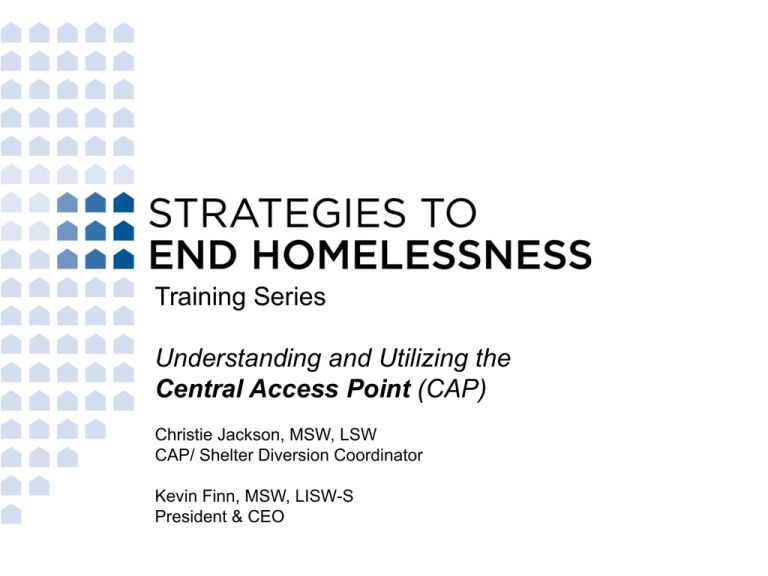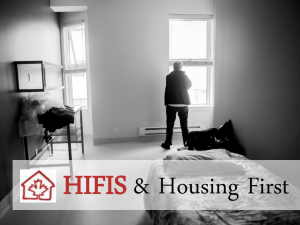
Training Series
Understanding and Utilizing the
Central Access Point (CAP)
Christie Jackson, MSW, LSW
CAP/ Shelter Diversion Coordinator
Kevin Finn, MSW, LISW-S
President & CEO
Central Access Point (CAP)
Training Objectives
This presentation will help those working with the homeless gain a
basic understanding of:
• Electronic Intake Process CAP uses to place
individuals and families who are homeless into
shelter and other programs
•Screenings and factors that contribute to
placement into programs
•How to connect clients who are homeless or
facing homelessness with CAP
•Things CAP callers should know about
accessing services
What is the Central Access Point
•Single point of entry for homeless individuals and
families seeking emergency shelter
•Completes electronic intakes, screenings,
referrals, and placements using VESTA
•Makes referrals and placements to individual
shelters, family shelters, transitional housing at
Parkway Center, Supportive Service for Veterans
& their Families (SSVF), and the Shelter
Diversion Program
Where is CAP
•CAP is a program of Strategies to End
Homelessness and operates in their office. CAP is a
telephone only service and does not have a walk-in
component.
•Hours of operation:
o
o
Monday- Friday 10am-8pm (CAP takes calls at 9am for
individuals seeking placement in shelter/transitional
housing)
Saturday-Sunday 10am-2pm for all calls
•Highest call volume: 10am- 12pm Monday- Friday
•Operated by six intake specialists (three full time
staff during the day and three part time staff on
evenings and weekends)
Who Should Access CAP
• Anyone who is in need of shelter
– If they have no place to sleep tonight
– If they going to be without a place to sleep within
the next week
• Who should not call CAP
– People behind on their rent/ utilities or looking for
financial assistance
– People who receive a notice to vacate
– Those who are able to stay with friends or family
– People who do not want to go into shelter
– People only wanting a homeless certificate
CAP should only be called if a person is in
imminent need of shelter and is able to go
into shelter that day
Who Should Access CAP
• CAP is for people looking to get into shelter
PLUS:
– Veteran families who are homeless or at risk
of homelessness
– Single men wanting to get into Parkway
Center
• CAP must talk to person needing services before
placement is scheduled
– Other people can call to inquire about space but beds
won’t be held until the person needing services
contacts CAP directly
CAP Placements and Referrals
• Family Emergency Shelter
Mercy Health at St. John
Interfaith Hospitality Network of Greater Cincinnati
The Salvation Army
Bethany House Services
• Emergency Shelters for Singles
St. Francis / St. Joseph Catholic Worker
House (men able to work)
Lighthouse Sheakley Center for Youth (men and
women age 18-24)
Bethany House (women)
DIC women’s dorm
New women’s shelter (2014-2015)
City Gospel Mission (single men) (2014-2015)
CAP Placements and Referrals
• Supportive Services for Veteran’s Families
Goodwill and Talbert House- both have RRH
and prevention programs
•Transitional Housing
Parkway Center
• Shelter Diversion
Freestore Foodbank
Jewish Family Services
Mercy Health at St. John
Emergency Shelter Eligibility
All shelters require that you have no where else to stay and
no longer have keys to an apartment
Family shelters require at least one child under 18 entering
shelter with you
Can place single head of household (male or female) or
couples with children- will accept same sex couples with
children
No shelters accept couples without children
Shelters do take boys over age 12
If a child is over 18, they must still be in high school to go
into family shelter with family; if not, they need to seek
shelter on their own
No sexual offenses
Emergency Shelter Eligibility
• Catholic Worker House is for single men who
are willing and able to work- must secure
employment within 30 days
• Lighthouse Sheakley Center for Youth is for
single men and women ages 18-24- a step up
shelter that requires people to work a case plan
that addresses income and housing
Supportive Services for Veteran’s
Families (SSVF)
• There is a Veteran in the household that served
beyond basic training and has anything other than
a dishonorable discharge
•Homeless or at imminent risk of homelessness
(within 14 days)
•Household income below 30% AMI
•No other financial resources or support networks
to prevent homelessness
•Serves Boone, Butler, Campbell, Clermont,
Hamilton, Kenton, and Warren counties
Shelter Diversion
VS
Homelessness Prevention/Rapid Rehousing Program (HPRP)
HPRP
Shelter Diversion
•
•
•
•
•
• ESG funding= less $
• Targeting people who
are already doubled up
and will be entering a
shelter
• More stringent criteria
• Smaller case loads
Stimulus funding
Eviction Prevention
More money
Money had to be spent
Larger case loads so
could accept more
people
Shelter Diversion
• Imminent risk of entering shelter
• Household income is less than 30% AMI
• No other support networks or financial
assistance to prevent entering shelter
• Willingness to work with a CM
• No active homeless certificates, shelter stays,
previous HPRP assistance or shelter diversion
assistance within past 12 months
• Hamilton County resident
Shelter Diversion
• If a person meets criteria for Shelter Diversion,
and has a safe place to stay, CAP makes referral
to a Case Manger in the program
• Case Manager and Housing Specialist assist
client with finding housing within 30 days
• Financial assistance is provided to help obtain
and maintain housing
•Please do NOT tell your clients to call for Shelter
Diversion- if they are in need of shelter, have
them call CAP.
•Every person calling for shelter is being
screened for Shelter Diversion
Transitional Housing
• Mt Airy Center closed and is now Parkway Center
Transitional Housing operated by Talbert House
•Single male (Veterans & Non-Veterans) needing
substance abuse treatment
• Non-Vets need to have current homeless certificate
and be referred from shelter or street outreach worker
where homeless certificate was issued
•Veterans call CAP for a Grant Per Diem (GPD) bed
•No sexual offenses or open warrants
•Must be clean and sober
CAP DOES
Inform callers of availability of shelter beds & refer to programs•
Information is recorded in VESTA in real time
•
Once a program has updated their availability, CAP is
able to place someone else there
Place people in appropriate beds•
A person may contact a shelter and be informed there is
space and instructed to call CAP, but CAP may tell people
there isn’t room due to several factors:
•
Shelter may not have exited person in bed finder so
bed still looks occupied
•
Another person contacted CAP at the same time &
was placed into the beds first
•
Available beds might not fit person’s household.
•
If there are only 2 beds available, CAP can’t place
a family of 6
CAP can only place people when availability is shown in bed
finder. If shelters haven’t updated VESTA, new people can
not be placed in a bed
CAP DOES
•
Need to talk to the person directly seeking services
•
Adjusts to each shelter/ program and follows their eligibility
guidelines. CAP knows the different requirements for each
program and is able to place people in the program that best
fits their needs
•
Place callers into shelter according to the intake times the
shelters tell CAP they are available
•
Inform callers of ineligibility for services if noted by former
agency in VESTA
•
If a program noted that a household is ineligible to
return, CAP staff will not the refer person to that program
•
Maintain a “Call Back List” for families on the street
•
CAP will attempt to call a family back when space
becomes available but beds aren’t held.
•
If CAP does not reach the family, the beds may be given
to another caller
CAP Does NOT
•
Have the ability to make shelter beds available. Shelters
make beds available in bed finder before CAP can make
new placements
•
Schedule shelter placements for more than 24 hours in
advance. Intakes are scheduled for the same day.
•
Tell shelters/programs what their eligibility criteria should
be. Each program tells CAP what their eligibility
requirements are.
•
Have a waiting list
•
Transport clients to/from shelter
•
Have a walk in component
Clients entering shelters without referral
from CAP
• Since CAP places households who are most
imminently in need of shelter, intakes outside of CAP
may give beds to people whose situation is less
desperate
•Word will spread and people will call shelters
directly to get in instead of CAP
Since CAP does everything over the
phone:
• All referrals are based on self reports
•Only exception- Parkway Center
• People sometimes tell CAP what they think CAP
staff “want to hear”; story may be a little different
what they arrive at shelter, etc.
•If people report something that makes them
ineligible, please contact CAP to find out what
information they disclosed to CAP
•If any questions about a referral, please call CAP
staff or CAP supervisor
Factors that Contribute to Placements
and Referrals
Space- Are there available beds in shelter or other programs for
referrals? Shelters have a fixed number of beds. Shelter Diversion and
SSVF has a fixed number of openings.
Eligibility- Did the caller meet the eligibility requirements according to
the screening? Is the individual/family eligible to return to shelter? The
prevention program and shelters have eligibility requirements. Each
program tells CAP their eligibility requirements
Self Determination- What course of action does the caller want to
take? Family, friends or case managers may think the person needs to
go into shelter but that has to be what the person wants
Immediacy- How soon will the caller become homeless? How soon
are they able to enter shelter? How urgent is their need for services?
Program Suitability- What program best meets the needs of the
caller?
CAP Improvement
• CAP has been meeting with shelters who are on CAP to
discuss ways to improve the working relationships
• Procedures were developed between CAP and the shelters
• Will have ongoing meetings to strengthen the relationship
between CAP and shelters
• CAP survey collected feedback from shelters, programs and
other community providers
CAP Survey results
• 22 people completed the survey- average overall rating was
6.69 on a scale of 1-10
• Recommendations to improve CAP assessment
•Multiple comments about the difficulty getting through when
CAP lines are busy
• Many comments about lack of available shelter space. CAP
has no control over shelter beds or when space is available at
shelter.
CAP records clients’ needs in VESTA
CAP checks for shelter availability and reserves
beds in VESTA Bed Finder
CAP continues to expand
The Single women’s shelter and the City Gospel
Mission for single men will come onto CAP when they
open in 2014-2015
CAP 2013
There was a total of 21,404 calls from 4,596 callers
Family shelter- 12,384 calls from 2,187 callers
489 placements
Individual Shelter- 4,755 calls from 1,486 callers
169 placements (31 to BH, 13 to CWH, 124 to
Lighthouse, 1 to DIC women’s dorm)
SSVF- 646 calls from 411 callers
272 referrals
Transitional housing- 1,917 calls from 473 callers
207 placements
Shelter Diversion- 221 referrals; 753 total people served; total
financial assistance $544,511, 170 exited in 2013 with 3.5%
returning to homelessness
CAP Quick Review
513-381-SAFE (7233)
Monday- Friday 10am-8pm, Saturday-Sunday 10am-2pm
• Completes electronic intakes and placement into family/single shelter, shelter
diversion, and SSVF
• Assists single males/females, families, single parents
• Is a single point of contact, no need to call several agencies
• Completes screening completely over the phone, no walk in service
• Makes referrals and placements into:
Emergency Family Shelter( FSP)
Mercy Franciscan at St John
Interfaith Hospitality Network
The Salvation Army
Bethany House Services
Emergency shelter singles
Bethany House Services
Catholic Worker House
Lighthouse Sheakley Center for Youth
DIC women’s dorm
Single women’s shelter (2014-2015)
City Gospel Mission (2014-2015)
Transitional Housing
Parkway Center
Prevention Services
SSVF- both RRH and prevention
Social Services agencies for Shelter Diversion
QUESTIONS?
For more information, please visit our website:
www.strategiestoendhomelessness.org
Email CAP: CAP@end-homelessness.org
Call CAP:
513-381-SAFE (7233)
Contact CAP Supervisor: Christie Jackson
513-263-2793
cjackson@end-homelessness.org







